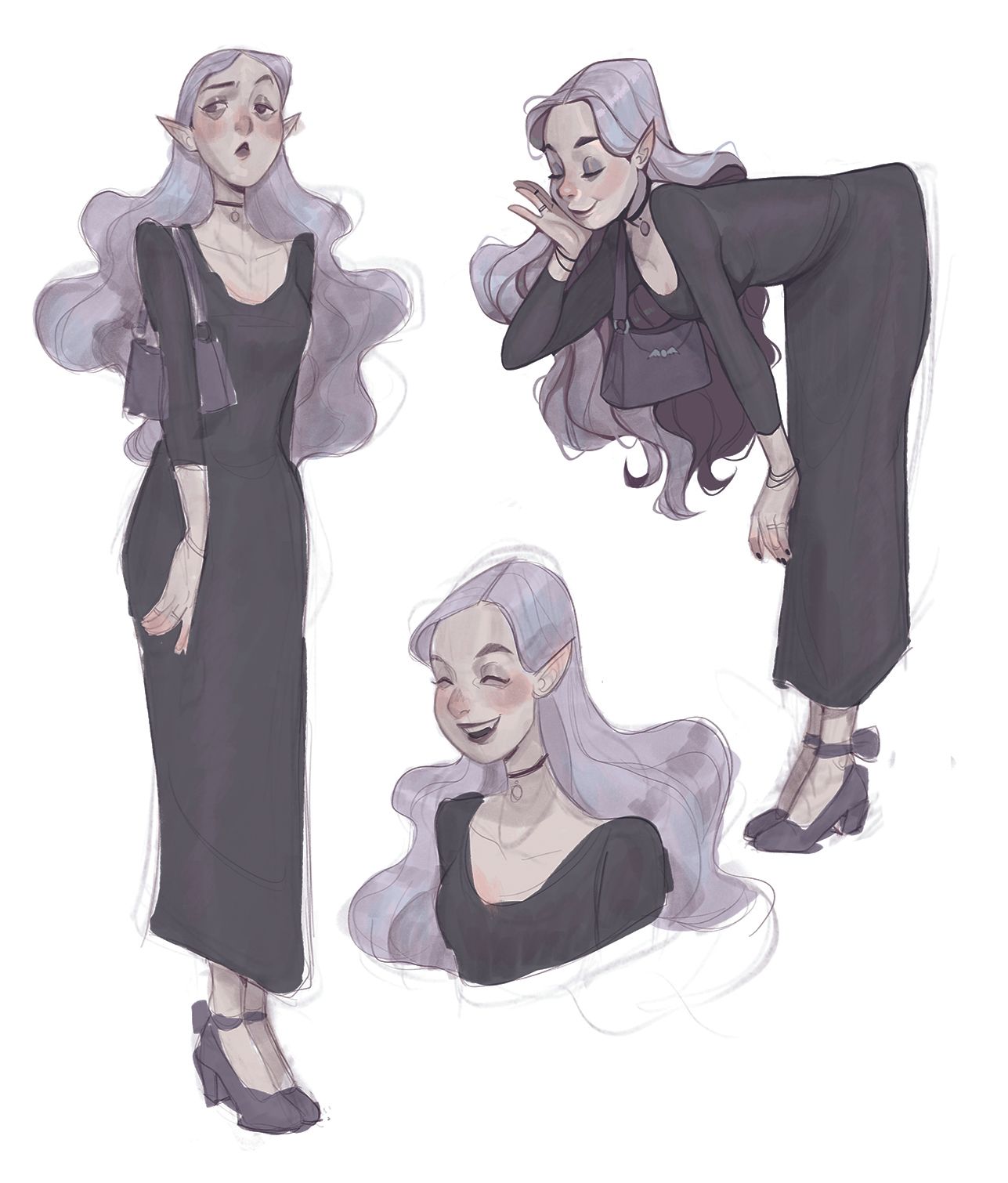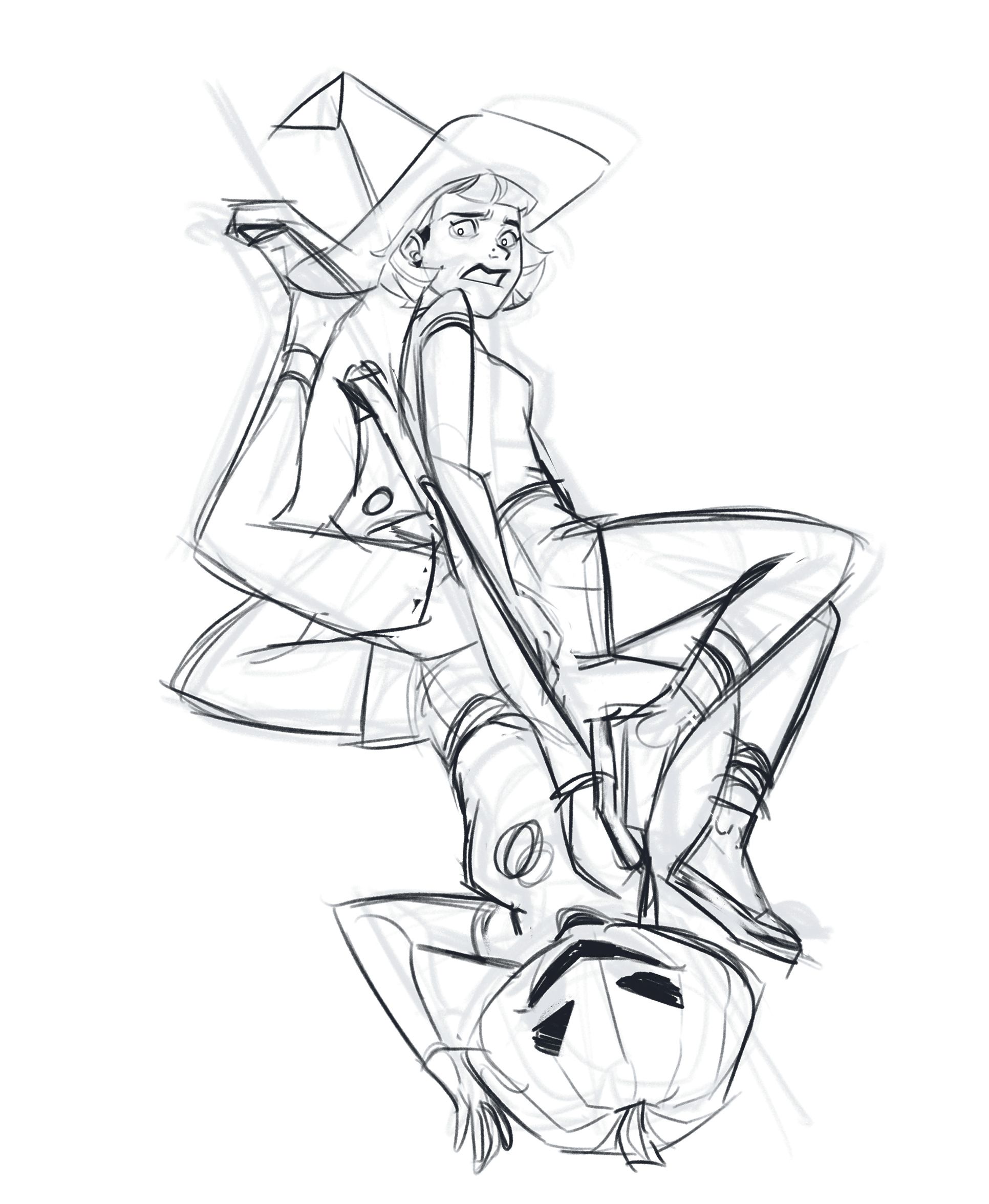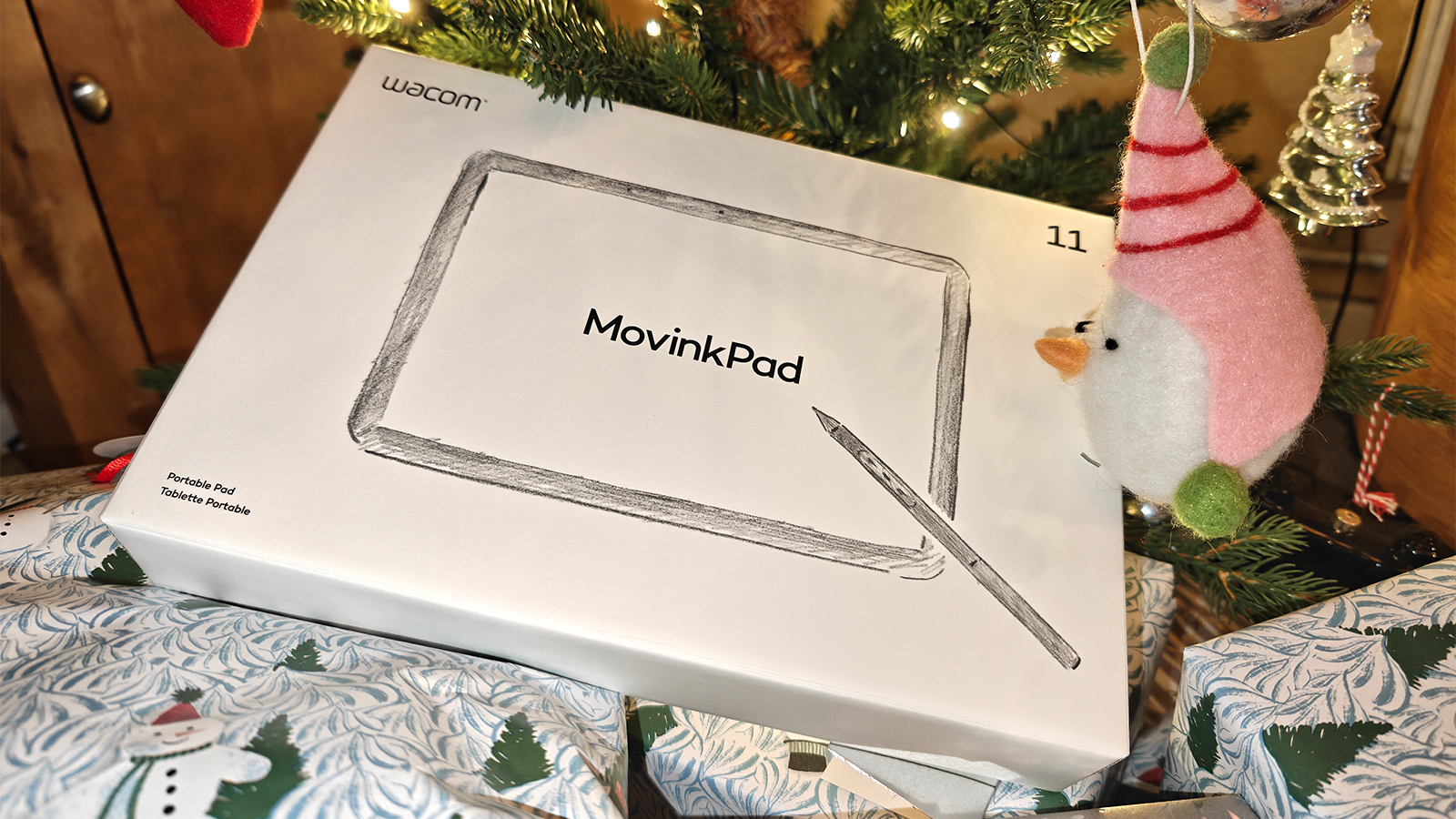How sketching “mini studies" helps this artist defeat the blank canvas
Alix Hillmer tells us how she uses her sketchbook to test ideas and expand her skills.
Alix Hillmer's passion for creatures like witches, monsters and mermaids shines through in her work thanks to vibrant use of colour. Predominantly a digital character artist, she melds colourful with creepy in her cartoon creations inspired by monsters, manga and myths.
Open her sketchbook and there’s more to be found: experiments in traditional mediums and brand new styles. We got the chance to sit down with Alix to learn more about her journey and how she uses her sketchbook to test out new ideas. If you're inspired, see our pick of the best sketchbooks and the best pencils for artists.


What got you started as an artist?
I’ve always been into art and wanted to create something colourful and fun. I grew up around art at home. Both of my parents are artists themselves. We my parents are artists themselves. We have always had – and they still have I would always sneak sheets of paper my parents are artists themselves.
We have always had – and they still have – an art studio at home. I would always sneak sheets of paper and Micron pens from my dad to draw from shoujo manga and Sailor Moon. I loved the characters and the magic of the worlds they were in, so I would create my own characters and stories for them.
As I got online, I began to see the work of artists from all over the world. That exposed me to so many different styles and techniques that I wanted to learn myself and replicate within my own artwork.
I started to take art more seriously as I got into my 20s. After spending a few years in a fine art program in college. I began to gravitate to character design and illustration. I focused on creating fun, engaging characters that, to me, told their own interesting stories. The visual language using shapes, colours, clothing, expressions and settings truly captures me and is always something I continue to work towards.

You manage to make the dark and creepy bright, cute and colourful. Was this always your intention?
I think I’ve always loved things that are cute and colourful! It’s something I love to include in my art. I’m inspired a lot by the early 2000s and the over the-top feeling of that decade.
The darker side of my work is something that I intentionally added in as an experiment initially, but over time has become one of my favourite elements to add! I enjoy taking my love for all things cute and colourful, and mixing it in with something more like a campy horror film. There’s something fun about combining those two concepts.

What is your working environment like and how does that inform your art?
I currently have a studio setup at home that I share with my husband, who likes to game. We didn’t do much with it until last year when I made the space more comfortable and creative for me.
I added a colourful mural on one wall, new shelving for supplies, hanging up art prints from artists who I enjoy, and getting a standing desk, which helped complete my perfect little art den right at home.
When I want some time out of the house, I like to take my iPad out on the go with Procreate. It’s fun to grab a cappuccino at my favourite coffee shop and just doodle while taking in the sights and sounds all around me. I usually have my noise-cancelling headphones on and like to listen to music, mostly electronic and pop, or anything that has a fun beat to it.
I recently got into more fantasy novels, so I’ve also been listening to a lot of audiobooks! I notice that I begin to sketch up the characters from these stories. So it’s more something to listen to during a relaxed sketchbook session and not working on a major project.

Do you see sketching as a form of practice or for exploring new ideas?
I find that sketching, both digitally and traditionally, is more of a meditative exercise for me and can be an unstructured process. It’s more finalised piece, I get stuck and frozen by the pressure of the idea.
A lot of my meditative exercise for me and can be an unstructured process. It’s more where I go if I’m trying out a new technique, doing some fun studies, or playing around with my supplies and tools. If I go into it thinking of a finalised piece, I get stuck and frozen by the pressure of the idea. A lot of my sketches are just random doodles of characters I’ve done when I have a moment to sit for a bit.
My digital sketches particularly will tend to be where I’m a little more structured. But I’m more experimental with concepts, since I can copy and paste, move pieces around with the Lasso tool, and edit colours at will.
I like to pull random references or drawing challenges and work from there. Sometimes it’s various animals or interesting poses that I find. A lot of these turn into most of my final pieces! With one piece that I recently finished, I started playing around with some floating poses while I was at comic-con. It eventually became a fully rendered piece once I returned home.

Do you have any visual rules you like to stick to even in doodles or sketches?
My biggest thing right now is shape language. I try to get the initial shapes down during the first few lines and sketches. It’s all rough and messy, but if the shape of the character’s pose, or the composition of the image is there, it’s readable to me.
I then tend to do a second pass over with more details, making sure not to cover up any of the foundational shapes but reinforce them. Traditionally, that would be with a darker, softer pencil or some ink. Digitally I’d use a new layer on top of the initial sketch at a lower opacity.
If I’m adding colour to a sketch, I like to start off with a main base colour and then play around with the hue and saturation of different spots. My colour rules tend to be one or two bright and punchy colours, with everything else complementing the main colour. I’ll add a touch more variation to hues in areas that I want to focus more on, for example the facial expressions.

How do your sketches reflect the tone you’re going for?
Since this is more of an intuitive process for me, I gravitate towards the cheerful things first before I begin to twist them around. I want to play with the expressions, the overall shape of the pose, the movement – all of that.
I try to achieve this by keeping my sketches very rough and loose at the beginning. As I start to get a clearer idea, I’ll begin to tighten up my sketch. This is where I’ll add in some of the darker and crazier elements to my sketches, such as extra arms, fangs, and all sorts of fun, spooky things.

Do you have a predefined idea of the world your characters inhabit?
It depends on the character that I’m working on or drawing. Most of the time I have some idea of the world or the basic character traits that I reference in my own head. I think the world that a character exists in does play a huge role in who that character is, from their choice of clothing to their attitudes. It’s something I keep in mind as I work.
One group of characters – Valentine, Phoebe and Astrid – are cosmic magic girls from another world. They’re all fishes-out-of-water with magical aura. When I sketch them, their story has them be a bit impassive, less expressive, but also more heroic and benevolent. I like to draw them as classic movie monsters too, where they’re a little more chaotic and more expressive.
Your drawings often lean into visual clichés and twist them in some fun new way. Can you share your process for this?
This is more instinctual for me! I enjoy playing around with clichés. I think they’re instantly readable and easy to understand. For example, it starts with me deciding if I want to draw a witch – something I know visually and easy to put down either on paper or a new canvas in Procreate.
As I’m sketching out different poses, I’m asking myself, “What if it’s a witch, but they’re also grocery shopping?” or, “Do they have a cat with them?” to come up with new scenarios to put this character in.
I do the same thing with character expressions. It’s less about drawing a character being happy, sad, or angry, it’s more, “This character is staring at their creepy double. Are they really freaked out or slightly amused?”

Are there any characters or styles you haven’t yet worked on that you would really love to tackle?
I really want to get into more of the fantasy archetypes and characters. I’m a big fan of Dungeons & Dragons and have spent far too many hours playing Baldur’s Gate 3 as well. Since I’ve been getting in to fantasy novels at lot more recently, it’s a theme that I really want to explore in my artwork!
I want to try and play around with more medieval fashion and costumes from all over the world. It also opens up new creatures and fun magical elements. My main goal with that is to create characters or illustrations that are based on D&D classes.
I’m also into fitness outside my art. I love to run long distances and powerlift, so I want to start playing around with muscle structure and athleticism, and bringing in some of my feelings and struggles as a gym rat. It sort of brings my two separate passions together in its own way.

What guidance would you give to someone who is just starting out in their art journey?
I want to say work on your passions and really get engaged with them. Find yourself in your artwork, whether that be through using the mediums that you enjoy the most, or the subjects you love to draw above all others. That isn’t to say you shouldn’t focus on your fundamental skills and draw out of your comfort zone.
I think those are just as important to learn and can add a better foundation to your work. It’s similar to fitness in a way for me – find the art you love to make and really get into it!
Discover what your comfort zone is and what you enjoy about your process the most. Then find some time to still work on the things that support it, such as the anatomy, values, the composition and the shape language through studies. Try to draw consistently, balancing between the two. You don’t need to draw every single day – you need your rest days as well – but try to create a schedule that works for you.
How "mini studies" help Alix defeat the blank canvas and expand her skill set

One thing I love to do is what I call “mini studies” during a sketch session. If I ever feel intimidated by the blank canvas or screen in front of me, sometimes I’ll tackle a small study session. These are meant to be quick, just focusing on getting the shapes down and adding some interesting colours. I try to pick a subject that I don’t normally do for these, whether that’s a more complex pose, an object or an animal of some form.
For these little chickens, I kept my time short on each one. The goal was to get a basic shape idea for the body. I focused on simplifying the shape first, then adding some basic details for the feathers.
When I went to add colour, I tried to keep everything unified between them. The patterns of the feathers were kept simplified with a textured brush and the Lasso tool. I also added a bit of value to enforce some of the roundness.
From sketch to final illustration

A lot of my sketch sessions can turn into a full illustration. My piece Creep is a great example. I started this one by putting down a random pose while sketching. I loved the idea of floating like a haunting ghost, and I decided to explore the concept further by making the ghost a mischievous character.
I added more detail to strengthen this concept, such as giving her extra bandages and plasters, and a bit of a smirk that makes her seem more scruffy or clumsy. When I wanted to fully push this sketch on into an illustration, I took the cleaned-up version you can see on the bottom left, and merged it with rougher sketches underneath.
Daily design news, reviews, how-tos and more, as picked by the editors.
I like to try and retain some of my sketch as I move into adding colour and rendering. My colour process mirrors my sketch process. For this piece, I focused on vibrant greens to get a sensation that feels a more creepy and slimy sort of horrifying. The glowing eyes were added to give it a bit more horror on top.
Testing new tools
While I’m primarily a digital artist, I do love to work in my sketchbook. These sessions are more relaxing for me and offer me a break from trying to create a finalised piece. Sometimes I come up with a sketch or character in my sketchbook and will take that sketch to refine digitally.
However, most of my traditional sketching is done to play around with new supplies and learning more about traditional mediums. Right now, my favourite traditional tools to use for drawing in my sketchbook are either a 0.7mm mechanical While I’m primarily a digital artist, I do love to work in my sketchbook. These sessions are more relaxing for me and offer me a break from trying to create a finalised piece.
Sometimes I come up with a sketch or character in my sketchbook and will take that sketch to refine digitally. However, most of my traditional sketching is done to play around with new supplies and learning more about traditional mediums. Right now, my favourite traditional tools to use for drawing in my sketchbook are either a 0.7mm mechanical pencil or a Prismacolor Col-Erase pencil.


You can see more of Alix's work on her Instagram profile.
For more insights into how pro artists use their sketchbooks, see our interviews with book cover author Dan dos Santos and character designer Greg Baldwin
This article originally appeared in ImagineFX. Subscribe to ImagineFX to never miss an issue. Print and digital subscriptions available.

ImagineFX is the No.1 selling digital art magazine for fantasy and sci-fi enthusiasts! Featuring digital and traditional drawing skills, game design, manga and film art each issue is crammed with training and inspiration from leading artists in their fields. Whether it's learning from comic art's Adam Hughes, fantasy art's John Howe, or digital painting's Loish, ImagineFX has you covered. ImagineFX has been inspiring artists for over 15 years!
You must confirm your public display name before commenting
Please logout and then login again, you will then be prompted to enter your display name.
